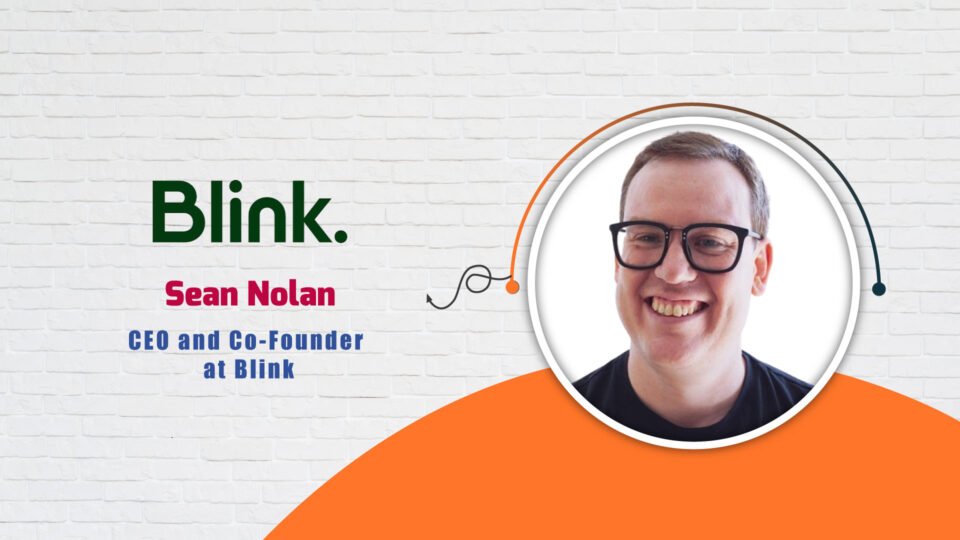Explore the inspiration and journey behind founding a super-app that revolutionizes connectivity and productivity for frontline workers.
Sean, can you introduce yourself to our audience and share the inspiration behind founding Blink?
I’m Sean and I am the co-founder and CEO of Blink, the super-app for frontline workers. Blink brings all the benefits of digital connection to the frontline worker – bringing everyone and everything together, closing the connection gap that exists between desk-based and frontline colleagues. Our app gives employees a single entry point to everything they need to support their working life – communications, productivity tools, people and processes, all through one app on their phones.
Blink was born out of challenges I experienced at a former company of mine. A large proportion of our workforce was remote and met only occasionally for quick company updates. I noticed that so many team members were struggling to feel connected to each other and their team leaders, and the entire culture suffered as a result.
I made it my aim to change that experience and, after listening to what my colleagues said would genuinely have the most impact, set about creating technology that would deliver meaningful, positive change to workers’ roles.
This turned out to be the very first iteration of Blink. And while there were a few bumps in the road getting our tech to hit the mark, we eventually nailed our proposition and target market, and quickly won our first major client, launching to 24,000 workers at Stagecoach, in 2019.
Blink extends the digital revolution to every worker – so everyone feels connected, but also allows companies to digitise their entire end-to-end operations – lowering costs and increasing staff satisfaction. It’s true win-win.
Today, we serve more than 300 leading frontline-first companies like Domino’s, Tonkotsu, Saint Luke’s Hospital, Elara Caring and Falck Ambulance.
What’s the overarching vision that drives Blink’s mission and development?
Our mission is to create connected workforces in which everyone thrives. Put simply, that means helping frontline-centric companies to become better and more effective places to work, which is precisely what they need to do to become a more successful company overall.
Culture and productivity are the top priorities for most CEOs – Blink directly transforms both for the largest part of the workforce.
Technology is the driving force behind making this possible – and by harnessing tech that is specifically designed with frontline workers in mind, we can continue to improve the working lives of individuals the world over. That is the vision that gets me out of bed every morning.
What benefits do companies gain from utilizing Blink’s product?
Frontline workers face numerous different challenges on a daily basis: isolation, working in silos, a lack of connectivity and collaboration, no direct channel of communication with their superiors, limited access to flexible working, no meaningful way to share feedback or ask for support, outdated reporting and forms – the list goes on. Blink puts all this – and a lot more – in the palm of their hands. Taking away huge amounts of friction, frustration and cost by simplifying how people work.
For example, by offering single sign-on, mobile-enabled access to all critical tech applications, we greatly improve accessibility and uptake. We allow employers to build easy-to-access content hubs so workers can access important information and resources whenever they need it. We replace paper trails with simple and intuitive mobile forms, helping employees improve efficiency, and we eradicate convoluted IT support tickets so that time-poor workers are not put off asking for assistance. Secure mobile-first chats facilitate better communication, while mandatory reads can ensure employees don’t inadvertently delete important updates.
All of these tools – which are available through our super-app – help ensure frontline employees’ needs are being met and that they are valued and respected by their employers, something which can have a transformative impact on company culture, leading to greater productivity, higher retention rates and overall business growth.
Can you highlight some distinctive features that define Blink’s platform? How does Blink distinguish itself from competitors in the market?
First, this is about simplicity. You won’t find a better mobile-experience in the enterprise. We’re the only platform to bring together all the elements workers need, and securely make them available through one app.
Another thing that makes Blink unique is our ability to collate a vast array of data points on a company’s workforce – such as how its existing technology, systems and tools are used by frontline workers – and how staff are feeling and behaving. We bring all this together with turnover data, cohort analysis and even new-joiner surveys, to tell leaders exactly what they can do to improve their operations.
What are some prevalent pain points customers approach Blink with?
It’s interesting because so often customers come to us and say they have an ‘engagement’ problem – but they struggle to put their finger on what that problem actually is or how they can address it. All they know is that their teams feel disjointed and dissatisfied, which is ultimately impacting their overall culture and performance.
And yet, when I talk to frontline workers, no one tells me they want to feel more ‘engaged’ at work. What I do hear them say is that they want to feel more involved, have more transparency and more autonomy. They want to feel that their employer understands their needs and has their back – even if they’re not physically seeing them on a day-to-day basis.
But they also want more convenience – by providing convenient and easy to use technology people feel more valued and empowered.
It seems to be that ‘employee engagement’, at least for frontline workers, has been misunderstood to be mainly about culture initiatives, when actually it’s largely about how people interact day-to-day with the company.
And in most cases, there’s no single issue to blame. It’s a combination of factors – poor communication, outdated processes, a lack of 360 feedback – that lead to an overall sense of frontline disconnection and discontent. So what Blink does is take all the challenges and pain points felt by frontline workers, and provides technology-driven solutions that ease these points of tension.
How do you anticipate AI influencing employee engagement in the future? Which areas do you foresee being most affected?
Perhaps one day we’ll all be working for an AI boss – one that knows how we like to be managed, how we like to work and is able to get the best from us? In the short term, every part of the employee lifecycle will be improved with AI – from better hiring, smoother on-boarding, easier access to information, better performance analysis, training, fairer pay – you’ll see every software company improve their products and services using AI.
We’re already able to target communication – time, channel, language – to the right person at the right time. We’re already seeing AI-generated video that is able to read news updates in any language. This will become an extension of the employer brand and you’ll see companies invest in their ‘avatar’ with just the right tone of voice.
For us individually, the most noticeable short-term benefit will probably be around information retrieval, summarisation and assistants – that enable everyone to be more effective at their jobs.
For me, I’d really like to see an AI coach – who can monitor my work, interactions, colleague feedback, and help me become a better CEO. If everyone had a coach who could teach us things and help us be more effective, that would be pretty impressive.
What are your predictions for how work will shift over the next few years?”
We’re going to continue to see a rise in the status, pay and demand for frontline workers. As a society, over the past 50 years we’ve over-rotated towards academic qualifications and desk-based work. The AI-powered productivity gains for desk-based workers, at the same time as a shortage of frontline workers – nurses, hospitality, electricians – will mean many people will be better off financially if they learn a trade or new qualification in a frontline industry.
This power-shift will also drive a culture change in frontline organisations – with a focus more on the workers, and the organisation existing to serve those who serve its customers. This means more transparency, more empowerment and more inclusivity.
For desk-based workers, I’m a fan of the adage that AI won’t take your job – someone who knows how to leverage AI will take your job. So we’ll see an acceleration of those who are most adept at using technology getting ahead at work.
Lastly, could you offer a preview of upcoming product upgrades that your customers can anticipate?
We’re injecting AI into every aspect of our system – from content creation through to predictive analytics that will be able to foresee when and why workers might leave, and even suggest training for managers to help prevent this happening. We’re looking at using AI to create personalized video, summarise data, answer questions and end the need for lengthy forms. We’re delivering content in people’s native language and personalising the experience based on people’s working hours, location, role, and much more. We’re looking at how we can match people to shifts intelligently, and how we can be the CEO-coach that helps leaders improve their operations based on our unique view of the entire employee experience. Our position with a view over the end-to-end employee lifecycle has given us a unique perspective and unique data set that we are now leveraging.

Sean Nolan
CEO and co-founder, Blink
Driven by his early encounters with remote work challenges, Boston-based CEO Sean Nolan co-founded Blink in 2014. This all-in-one “super-app” empowers frontline workers with the digital tools, connections, and resources they need on their personal phones. Blink bridges the gap between management and millions of individuals across industries, from bus drivers to healthcare workers, fostering engagement, belonging, and a 26% reduction in staff turnover. With over 300 clients, and used seven times daily by 300,000+ workers, Blink is revolutionizing the frontline experience, one tap at a time.

